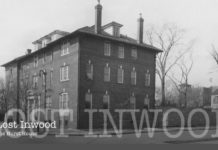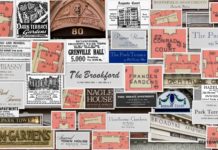
In the autumn of 1905 a New York newspaper reporter was sent uptown to explore the “quaint structures” that were “among the few remaining relics of great manors that once dotted the upper part of Manhattan Island.” (New York Press, October 22, 1905)
The writer’s prose was laden with nostalgia. The assignment was essentially an obituary—a farewell to a gilded era. Within a year the subway, then under construction, would arrive at Dyckman Street. Before long the few remaining summer homes and mansions of once famous New Yorkers would be bulldozed to make room for apartment houses.
Soon barkeeps, dentists and common laborers would descend on this formerly inaccessible region that once served as a seasonal playground to New York’s elite.
The writer described the good old days of the 1850’s and 60’s when it “was a more beautiful place than it is today.”
“There were more noble old trees, the meadows were innocent of docks and powerhouses, no trolley cars went racketing by in a swirl of dust,” the description began. “It was, in a word, the country; just such a place of sylvan beauty as the dweller in cites always longs for as being the ideal site for a home.”

In researching the article the author toured the remains of estates along Broadway between West 170th Street and West 216th Street. Among the stops: The lodge house on the estate of J. Hood Wright then occupied by the family’s former coachman, another lodge on the James Gordon Bennett estate, Benjamin Douglass’ old place and the gatehouse to the old Isham property on West 212th Street and Broadway.

The Isham gatehouse, according to the account, sat on a terrace twenty feet above Broadway and was occupied by a gardener during the summer months. The family of William B. Isham, a leather merchant and banker, lived atop the hill in an area today called Isham Park.
The news scribe, working ever north, described the surviving lodge houses that dotted Broadway, rarely venturing onto the estates they had once guarded.
As the writer approached West 215th Street the account became excited. While the majority of these lodge houses were “remarkably simple” wood frame affairs, “the last one approaches the magnificent.”

The writer had caught a first glimpse of the old “Marble Arch” built by John Seaman and Ann Drake-Seaman more than a half century before. (An arch, that by some incredible stroke of luck, still stands today)
“To everyone in the neighborhood of 215th Street the gatehouse of the Seaman or Drake place, as it is variously called, is always referred to as the ‘Marble Arch,’ not because it is built of that stone but because it was fashioned and named after the famous arch in Hyde Park in London.” (Author’s note: The arch is typically described as being a scale model of the Arc de Triomphe.)

“The Seaman who bought this land from the Dyckman tract,” the account continued, “was a warm admirer of everything that was British. He built his country house after the style of the houses that were erected along the Thames in the eighteenth century, out of a garish stone that was quarried on his property. The marble arch was built of the same stone and was the most striking piece of architecture in the way of a gate house in all of this colony.”
The Drake Seaman arch “differed from all the others for the reason that it was built directly over the driveway, with the gates swinging between the two supports of the arch.”

“The gates stand open now,” the reporter noted, “though, even rusted as they are, they show signs of the former tawdry grandeur of the place. The spikes above the black posts still show how once they were bravely gilded, and as you stroll through the grounds—for they are open to the public—you can see many signs of the old British influence in the classical statues, the stone lions guarding the steps of the many terraces, the conservatories, and the queer cupola with the statue that crown it above the corner tower.”
The old Seaman mansion, really a marble hilltop castle, was grand indeed. The home, named “Mount Olympus,” had looked over the northern end of Manhattan since the 1850’s. Neighboring farmers, offended by such an ostentatious display of wealth had nicknamed the estate “Seaman’s Folly.”

By 1910 the Seaman family has disappeared from the scene. The bulk of the property, at the time of the writer’s visit, was owned by real estate developer Thomas Dwyer who used the arch as an office. Dwyer often rented the crumbling old mansion to riding clubs and Suffragist groups. (Dwyer would eventually sell much of the property to developers who demolished the mansion in the late 1930’s to create room for the Park Terrace Gardens apartment complex)
The account took on a depressing tone as the writer realized that the arch was the only real surviving monument to a bygone chapter of New York history.

“That the glory of the marble arch is gone forever,” the scribe lamented, “may be seen from the fact that across its upper part is a great blue sign bearing the announcement that the place is for sale, and that there is an office in the arch itself.”
The writer closed his uptown tour with words that ring as true today as when they were written more that a century ago:
“These are simple structures, little buildings that in the course of a few years in all probability will go down before the northward movement of the city. Yet as they stand they are almost the only surviving monuments of an epoch of which there are scarcely any other traces in the social history of the city.”

Today the Seaman-Drake arch, covered in graffiti, is truly the sole survivor of that gilded age.
A century after this remarkable story was penned new zoning laws are being discussed.
Without proper protection and support the arch could be demolished to accommodate a new wave of building construction—And that would be a shame.









Thanks Cole!
A fascinating article. A question – in the 1925 photo of the Bway entrance to Isham Park do you know if (as I suspect is true) we’re seeing the same Gingko tree that stands there today?
Best,
Tom
Same tree. Its magnificent!